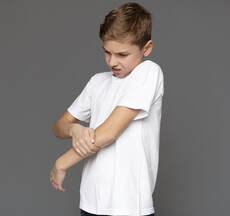What is juvenile arthritis?Juvenile arthritis is considered a rheumatic disease. It is the name given to describe rheumatic and inflammatory diseases that occur in children under the age of 16. According to the Arthritis Foundation, in the United States, juvenile arthritis affects about 300,000 kids. Most types of juvenile arthritis are considered an autoimmune disorder. What happens is for unknown reasons the immune system starts attacking the tissues of the body as if it was dangerous. The immune response leads to damage to the joints. SymptomsJuvenile arthritis can cause a vast array of symptoms. Some symptoms affect the joints, and some affect other organs of the body. Symptoms may also come and go. Some children go into remission and do not experience symptoms for many months. Possible symptoms of juvenile arthritis include the following:
How juvenile arthritis may affect the eyesAlthough juvenile arthritis affects the joints, it may also cause additional problems. In some cases, it can affect the eyes. Eye problems related to juvenile arthritis may occur from the disease itself or due to the treatment, as a side effect from certain drugs. Juvenile arthritis may lead to the following eye complications: Uveitis: Uveitis involves an inflammation of the iris in the eye. It is the most common eye complication associated with juvenile arthritis. Symptoms of uveitis include:
Usually, uveitis is treated with eye drops. If it is not caught early, it can lead to scarring in the eye and vision problems. Glaucoma: If uveitis becomes severe and is not treated, it can cause glaucoma and permanent vision loss. Cataracts: Although juvenile arthritis itself may not cause cataracts, the medication, such as steroids, used to treat it may increase a person’s risk. The chances of developing cataracts due to medication side effects increases the longer the child is on the drugs. It is important to understand that eye complications can occur anytime a child has juvenile arthritis. They may occur as soon as the child is diagnosed, or they could develop years down the road. The severity of the disease also does not appear to determine whether eye problems develop. Some children with mild joint disease develop eye complications. According to the American Academy of Ophthalmology, about 50 percent of children do not have obvious symptoms of eye complications at first. In many children, by the time they have symptoms, damage to the eye is already done. It is vital for children with juvenile arthritis to have an eye exam as soon as they are diagnosed with the condition and have regular eye exams after. TreatmentAlthough there is no cure for juvenile arthritis, there are ways to manage the condition. The goal of treatment is to slow the progression of the disease, reduce symptoms, and improve quality of life. By slowing down the progression, joint function may also be preserved.
Treatment may involve different types of medication, such as steroids to reduce inflammation. Physical therapy to maintain range of motion is also helpful. Additional treatments, such as using heat, massage, and topical pain relievers, may also be useful. Healthy eating habits and light exercise is also beneficial. A combination of treatments may be most effective in managing symptoms. If your child has juvenile arthritis and you have concerns about their eye health, see an eye doctor as soon as possible. We are happy to help if you have any questions. To discuss whether an appointment with one of our eye doctors would be appropriate at this time, please call our office at 508-746-8600. Comments are closed.
|
EYE HEALTH BLOGCategories
All
Archives
July 2024
|
|
Kadrmas Eye Care New England
55 Commerce Way, Plymouth, MA 02360
14 Tobey Road, Wareham, MA 02571 133 Falmouth Road (Rt 28), Mashpee, MA 02649 |
Phone Number:
1-508-746-8600 Hours: Monday through Friday — 8 AM – 4:30 PM |


 RSS Feed
RSS Feed
